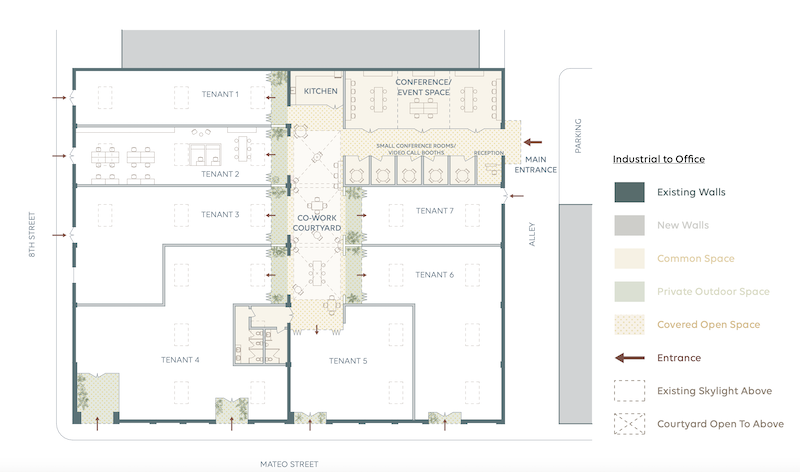The Los Angeles-based design firm Omgivning has released three white papers that propose new ways, post-COVID 19 pandemic, of looking at workplaces, multifamily, and urban reprogramming.
The firm’s ideas revolve around four unifying themes:
• Human-centric design
• Flexibility and adaptability
• Blended uses
• The relationship of space and economic context
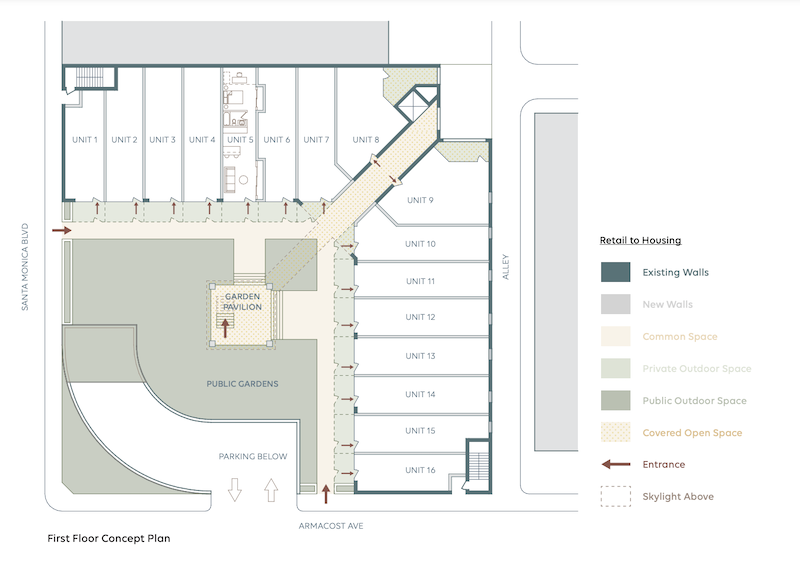
Big-box retail, which is under stress from online shopping, could be rethought for residential conversion with lots of open public areas.
Karin Liljegren, FAIA, IIDA, Omgivning’s founder and Principal, in 1999 worked on the very first projects under Los Angeles’ Adaptive Reuse Ordinance. Her firm’s recent white papers assume that changing social norms have created excess and unused capacity in the built environment. Those assumptions drive the various alternative concepts that Omgivning has devised, with an eye always toward reusing, as opposed to tearing down, existing buildings.
For example, Omgivning’s multifamily paper cites Preservation Positive, a report released by the LA Conservancy in 2020, that approximately three-fifths of Angelenos rent while the city remains in the middle of an ongoing housing crisis. “Rather than build itself out of this crisis, where the average cost to produce one new unit of subsidized affordable housing is at least $400,000, we should seek to find a more cost-effective, creative, and sustainable approach. Through enhancing the city's residential stock in existing buildings, we can help fill the gap toward achieving the City's housing goals.”
BREAKING DOWN THE MULTIFAMILY FORM
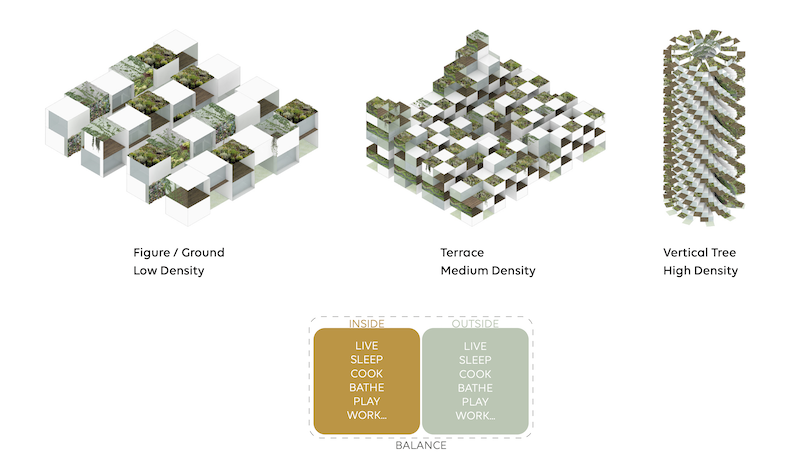
Multifamily buildings can achieve different density levels, depending on the amenities and biophilia included.
The multifamily paper offers four concepts:
• Humanizing the urban experience by providing features for existing urban apartment buildings that contribute to a greener, more porous city;
• Expanding unit types through designs that integrate diversity and flexibility into spaces for the inhabitants' various needs;
• Common spaces that emphasize a connection to nature, expand private work options in communal environments, and introduce on-site commerce; and
• Transforming interiors whose components are designed to be "both/and" solutions to meet multiple needs, as opposed to "either/or" that only allow for a single use.
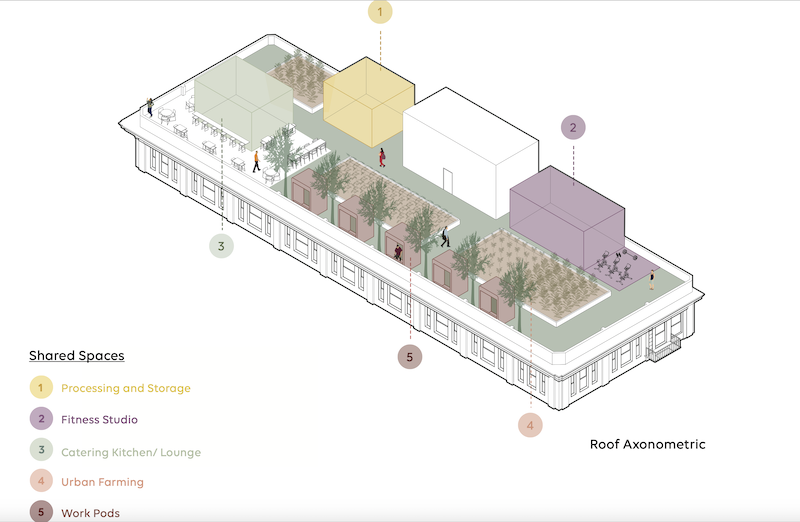
Shared and common spaces that could include roofdeck “work pods” are central to Omgivning's multifamily concepts.
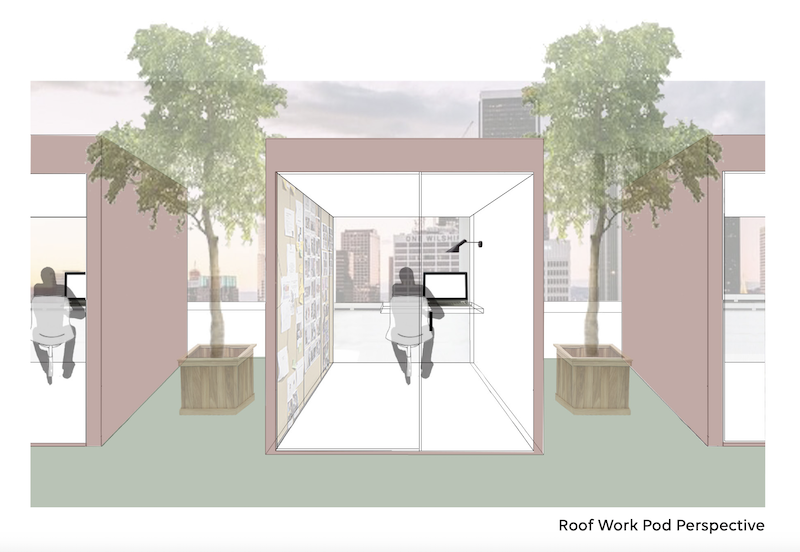
The paper deconstructs the multifamily form to incorporate open-ended light courts that allow natural light and ventilation to flow throughout. Its concepts expand the unit types within buildings to include two-story two-family, as well as private and “gather” zones.
“Opportunities also exist to create new experiences and interactions in areas once relegated to back of house,” the paper states, “or typically common to the street and sidewalk.” That might include relocating the mailroom to the front of the building and adding refrigerated boxes and larger parcel rooms. “Even the simple act of picking up mail presents a greater chance of engaging with neighbors.”
PODS FOR DIFFERENT USES
Omgivining is a big advocate for incorporating “pods” into its reimagining of buildings for privacy and utility. Pods are part of one of the firm’s alternate multifamily unit types. And Omgivning’s workplace paper presents three pod types that accommodate a broad range of needs:
The View Pod, designed for maximum resilience that supports unexpected shelter-in-place requirements. Enclosed on all sides with one main opening directed towards a chosen view, these pods could face exterior windows or a common open space within the office. In its workspace scenario, The View ensures privacy and sound isolation, while remaining visually connected to elements beyond. The sleep scenario can host a mattress for an overnight stay.
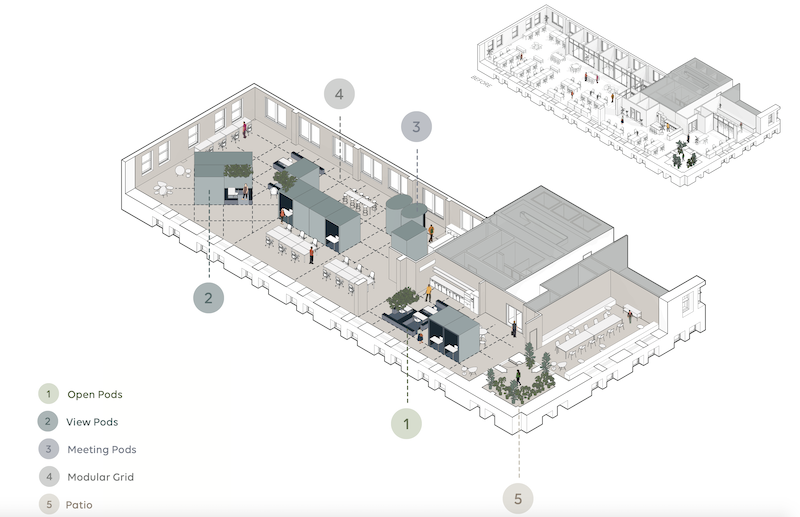
Omgivning reimagines the workplace with different kinds of intimate spaces, such as its “work-meet” pod that allows for privacy and collaboration.
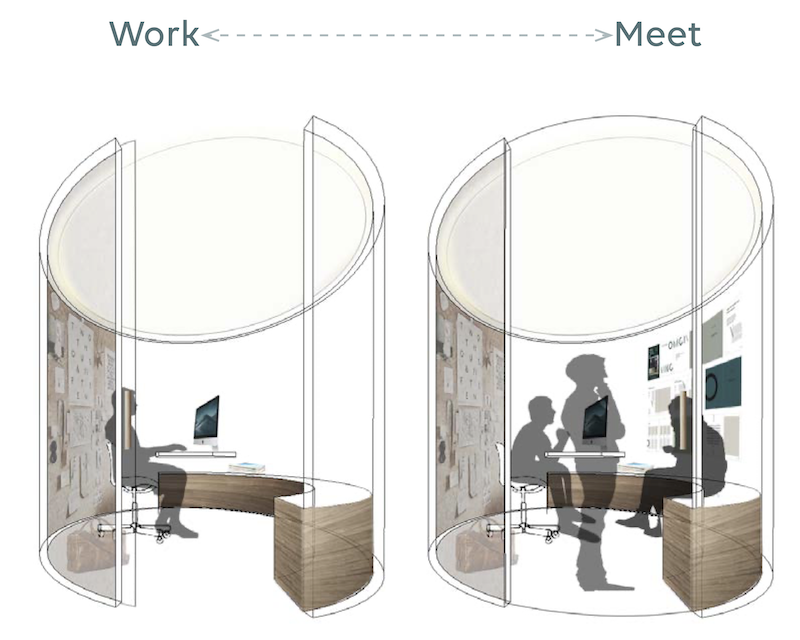
The Meeting Pod, which provides flexibility for open or enclosed meetings. Its circular footprint provides acoustic privacy for video calls and to aid in focus. Built-in millwork offers dual functions for seating and storage. Integrated lighting and tackable surfaces present a clean background for personalization and work-based pin-ups.
The Open Pod, which provides a modular footprint with varying barrier preferences. It defines an individual space while staying visually connected to the communal space. The barrier preferences are adjustable to an open or enclosed layout, based on the occupant's needs. Greenery, suspended from above or in planters, can be used to define zones and remind inhabitants to prioritize wellbeing. The Open Pod provides built-in lockers, open shelving and the option for a height-adjustable desk.
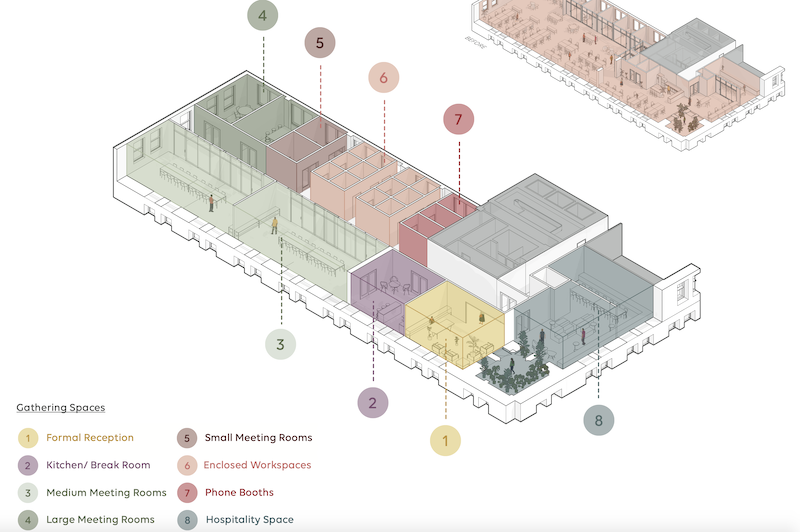
The workplace needs places where employees can still congregate safely.
The workplace paper also offers reuse concepts for gathering spaces and for better infection control, the latter of which helps employers assess workers’ needs by developing targeted protocols that focus on human impacts.
REVIVING TIRED RETAIL AND WAREHOUSE SPACE
In its paper on reimagining urban reprogramming, Omgivning cites experts who anticipate that 90% of real estate development over the next decade will focus on renovation and resuse, rather than new construction.
To that end, this paper proposes ways to transform struggling strip malls (there are 675 malls in Los Angeles alone), big-box retail (using an existing vacant 150,000-sf Costco in L.A. as its starting point), light-industrial warehouses, and urban ground-floor commercial space.
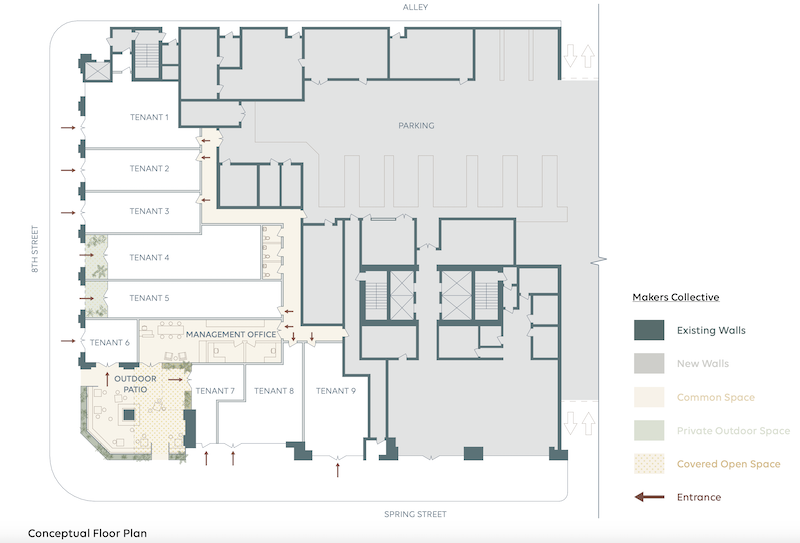
Light industrial space could be converted to leasable maker spaces.
Its vision for converting retail space to housing includes one configuration showing a mini-mall with the capacity to hold 30 600-sf affordable residential units, each outfitted with work-from-home capabilities, and an outdoor patio or courtyard.
Omgivning’s reuse of light industrial space includes an office concept that’s organized around a centrally located courtyard that provides users with cross ventilation, natural light, and connection to green outdoor space. It also conceived a live-work concept that carves up the building into smaller, more affordable lofts that are linked through outdoor courtyards, and are circulation-rich with greenery.

Restaurants and offices share some common traits that could be combined for converting ground-floor retail.
Transforming ground-floor retail could encompass what Omgivning calls a Makers Collective concept, where a master tenant, or even an existing building management company, can lease a large space and subdivide it into smaller units for individuals or small startups. The program consists of shared space to house equipment needed by the tenants, and a shared space for events and periodic showcases of the community’s products. An outdoor lounge and garden provide a communal gathering space.
Omgivning even goes so far as to suggest a restaurant/office hybrid concept that reduces each footprint by sharing the varied seating arrangements within a restaurant to accommodate individual and collaborative work.
Related Stories
Adaptive Reuse | Oct 22, 2024
Adaptive reuse project transforms 1840s-era mill building into rental housing
A recently opened multifamily property in Lawrence, Mass., is an adaptive reuse of an 1840s-era mill building. Stone Mill Lofts is one of the first all-electric mixed-income multifamily properties in Massachusetts. The all-electric building meets ambitious modern energy codes and stringent National Park Service historic preservation guidelines.
MFPRO+ News | Oct 9, 2024
San Francisco unveils guidelines to streamline office-to-residential conversions
The San Francisco Department of Building Inspection announced a series of new building code guidelines clarifying adaptive reuse code provisions and exceptions for converting office-to-residential buildings. Developed in response to the Commercial to Residential Adaptive Reuse program established in July 2023, the guidelines aim to increase the viability of converting underutilized office buildings into housing by reducing regulatory barriers in specific zoning districts downtown.
Adaptive Reuse | Sep 12, 2024
White paper on office-to-residential conversions released by IAPMO
IAPMO has published a new white paper titled “Adaptive Reuse: Converting Offices to Multi-Residential Family,” a comprehensive analysis of addressing housing shortages through the conversion of office spaces into residential units.
Adaptive Reuse | Aug 29, 2024
More than 1.2 billion sf of office space have strong potential for residential conversion
More than 1.2 billion sf of U.S. office space—14.8% of the nation’s total—have strong potential for conversion to residential use, according to real estate software and services firm Yardi. Yardi’s new Conversion Feasibility Index scores office buildings on their suitability for multifamily conversion.
Adaptive Reuse | Aug 28, 2024
Cities in Washington State will offer tax breaks for office-to-residential conversions
A law passed earlier this year by the Washington State Legislature allows developers to defer sales and use taxes if they convert existing structures, including office buildings, into affordable housing.
Adaptive Reuse | Aug 22, 2024
6 key fire and life safety considerations for office-to-residential conversions
Office-to-residential conversions may be fraught with fire and life safety challenges, from egress requirements to fire protection system gaps. Here are six important considerations to consider.
Reconstruction & Renovation | Aug 19, 2024
Movement to protect historic buildings raises sharp criticism
While the movement to preserve historic buildings has widespread support, it also has some sharp critics with well-funded opposition groups springing up in recent years. Some opponents are linked to the Stand Together Foundation, founded and bankrolled by the Koch family’s conservative philanthropic organization, according to a column in Governing magazine.
Adaptive Reuse | Aug 14, 2024
Adaptive reuse revives a former warehouse in St. Louis
The Victor, as the building is now called, has nearly 400 residential apartments.
Adaptive Reuse | Aug 14, 2024
KPF unveils design for repositioning of Norman Foster’s 8 Canada Square tower in London
8 Canada Square, a Norman Foster-designed office building that’s currently the global headquarters of HSBC Holdings, will have large sections of its façade removed to create landscaped terraces. The project, designed by KPF, will be the world’s largest transformation of an office tower into a sustainable mixed-use building.
Modular Building | Aug 13, 2024
Strategies for attainable housing design with modular construction
Urban, market-rate housing that lower-income workers can actually afford is one of our country’s biggest needs. For multifamily designers, this challenge presents several opportunities for creating housing that workers can afford on their salaries.


